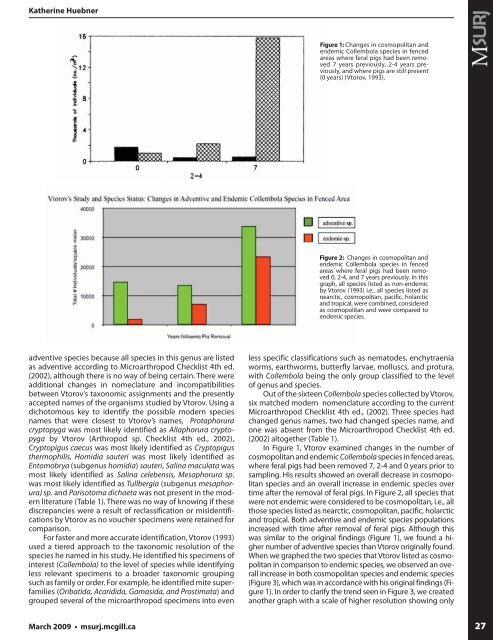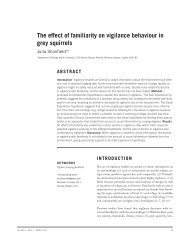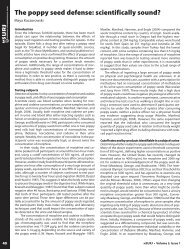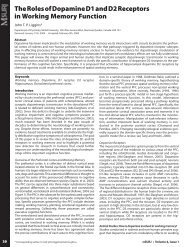the entire issue - McGill Science Undergraduate Research Journal ...
the entire issue - McGill Science Undergraduate Research Journal ...
the entire issue - McGill Science Undergraduate Research Journal ...
You also want an ePaper? Increase the reach of your titles
YUMPU automatically turns print PDFs into web optimized ePapers that Google loves.
Ka<strong>the</strong>rine Huebner<br />
Figure 1: Changes in cosmopolitan and<br />
endemic Collembola species in fenced<br />
areas where feral pigs had been removed<br />
7 years previously, 2-4 years previously,<br />
and where pigs are still present<br />
(0 years) (Vtorov, 1993).<br />
Figure 2: Changes in cosmopolitan and<br />
endemic Collembola species in fenced<br />
areas where feral pigs had been removed<br />
0, 2-4, and 7 years previously. In this<br />
graph, all species listed as non-endemic<br />
by Vtorov (1993) i.e., all species listed as<br />
nearctic, cosmopolitan, pacific, holarctic<br />
and tropical, were combined, considered<br />
as cosmopolitan and were compared to<br />
endemic species.<br />
adventive species because all species in this genus are listed<br />
as adventive according to Microarthropod Checklist 4th ed.<br />
(2002), although <strong>the</strong>re is no way of being certain. There were<br />
additional changes in nomeclature and incompatibilities<br />
between Vtorov’s taxonomic assignments and <strong>the</strong> presently<br />
accepted names of <strong>the</strong> organisms studied by Vtorov. Using a<br />
dichotomous key to identify <strong>the</strong> possible modern species<br />
names that were closest to Vtorov’s names, Protaphorura<br />
cryptopyga was most likely identified as Allaphorura cryptopyga<br />
by Vtorov (Arthropod sp. Checklist 4th ed., 2002),<br />
Cryptopigus caecus was most likely identified as Cryptopigus<br />
<strong>the</strong>rmophilis, Homidia sauteri was most likely identified as<br />
Entomobrya (subgenus homidia) sauteri, Salina maculata was<br />
most likely identified as Salina celebensis, Mesaphorura sp.<br />
was most likely identified as Tullbergia (subgenus mesaphorura)<br />
sp. and Parisotoma dichaeta was not present in <strong>the</strong> modern<br />
literature (Table 1). There was no way of knowing if <strong>the</strong>se<br />
discrepancies were a result of reclassification or misidentifications<br />
by Vtorov as no voucher specimens were retained for<br />
comparison.<br />
For faster and more accurate identification, Vtorov (1993)<br />
used a tiered approach to <strong>the</strong> taxonomic resolution of <strong>the</strong><br />
species he named in his study. He identified his specimens of<br />
interest (Collembola) to <strong>the</strong> level of species while identifying<br />
less relevant specimens to a broader taxonomic grouping<br />
such as family or order. For example, he identified mite superfamilies<br />
(Oribatida, Acaridida, Gamasida, and Prostimata) and<br />
grouped several of <strong>the</strong> microarthropod specimens into even<br />
less specific classifications such as nematodes, enchytraenia<br />
worms, earthworms, butterfly larvae, molluscs, and protura,<br />
with Collembola being <strong>the</strong> only group classified to <strong>the</strong> level<br />
of genus and species.<br />
Out of <strong>the</strong> sixteen Collembola species collected by Vtorov,<br />
six matched modern nomenclature according to <strong>the</strong> current<br />
Microarthropod Checklist 4th ed., (2002). Three species had<br />
changed genus names, two had changed species name, and<br />
one was absent from <strong>the</strong> Microarthropod Checklist 4th ed.<br />
(2002) altoge<strong>the</strong>r (Table 1).<br />
In Figure 1, Vtorov examined changes in <strong>the</strong> number of<br />
cosmopolitan and endemic Collembola species in fenced areas,<br />
where feral pigs had been removed 7, 2-4 and 0 years prior to<br />
sampling. His results showed an overall decrease in cosmopolitan<br />
species and an overall increase in endemic species over<br />
time after <strong>the</strong> removal of feral pigs. In Figure 2, all species that<br />
were not endemic were considered to be cosmopolitan, i.e., all<br />
those species listed as nearctic, cosmopolitan, pacific, holarctic<br />
and tropical. Both adventive and endemic species populations<br />
increased with time after removal of feral pigs. Although this<br />
was similar to <strong>the</strong> original findings (Figure 1), we found a higher<br />
number of adventive species than Vtorov originally found.<br />
When we graphed <strong>the</strong> two species that Vtorov listed as cosmopolitan<br />
in comparison to endemic species, we observed an overall<br />
increase in both cosmopolitan species and endemic species<br />
(Figure 3), which was in accordance with his original findings (Figure<br />
1). In order to clarify <strong>the</strong> trend seen in Figure 3, we created<br />
ano<strong>the</strong>r graph with a scale of higher resolution showing only<br />
March 2009 • msurj.mcgill.ca<br />
27









